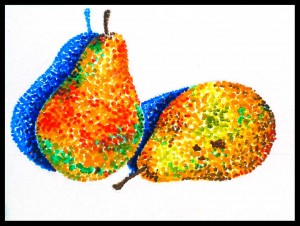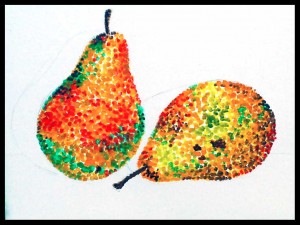This three pears is painted on 8 x 10 inches cold press watercolor paper. The left pear was painted first and then from left to right, each pear was painted with layers of watercolor wash. The background was painted last with several layers of Burnt Umber mixed with Winsor violet and Ultramarine blue. It is a challenge to mix black without using black watercolor paint. I have added some spatter with a tooth brush for the final touch on the pear watercolor painting.
Tag Archives: fruit
Daily Watercolor Painting – Loose Pear Study
Finished a 7 x 9 inches study of six pears in a group and wanted to try out the free and loose technique unique in watercolor painting. Sketch was done of the six pears on a cold press watercolor paper and big brush was used to layer in the background and pear color. It was done loosely and out of the sketch of the pears as you can see in the middle and lower part of the background. Orange color shows mixed with the background although the out line of the pear was always keep in mind as the first initial wash was done. Then after the first wash is dried to touch using a hair dryer, a second and third wash is applied and finally the pear take shape and the shadow and the stem was patinted quickly at various stages of dryness. It was fun and I have to work quickly to be free and loose. Next time I think I should have diluted the paint more with water and apply more layers until I get to the final stage.
Watercolor Paintng Daily – “Pear to Pear” Still Life
This is the final finished painting or study of pointellism using cotton swab. It teaches me the mixing of color visually when all the colors are placed side by side to each other. Watercolor straight from the tube is used and is only diluted by water. I found that using previouse hardened color on the palette is better for this techinque. It gives me a better control of how much color to apply. The hardened watercolor color is first got several spray mist of clean water from a small water spray bottle in order to soften it a bit. Most of the color I use in this study is from Windsor and Newton Artist watercolour. There is a wealth of information about watercolour pigments on their site.
Watercolor Painting – Pear to pear – still life
Shadows was added onto the watercolor painting by using cotton swabs for a study of pointellism. This is lots of fun and I use four different watercolor blues and I wish I have more different blues for this study. Windsor and Newton artist watercolour was choosen and used becasue of it billiancy and consistency.
Watercolor painting – Pear to pear
Did a little bit of watercolor on the watercolor study trying to use watercolor straight from the tube and applying it with a cotton swab. This is my way of study of pointellism in watercolor painting. Overall it was not a difficult process but much time consuming. The limit was the variety of watercolor paints I have at hand. If anyone were to try pointellism, they should have a good selection of watercolor paint.
Watercolor on cold press paper – “Pear to pear” 7 x 10 inches
Last night I tried my first watercolor pointellism. It is done on a 7 x 10 inches cold press watercolor paper. The color was painted on one dot at a time using the cotton swab. I think the dried watercolor paint is best for this technique but I shall experiment further. The dry watercolor paint in my palette is first sprayed with mist of water from a amall water bottle that creates fine mist. Then a cotton swab is wet with clean watercor and paint is transfer onto the swab by touching the paint. Pure pigment is being transferred to the paper one dot at a time keeping in mind the intensity and value of each dot of watercolor paint. I think with this techinque of not mixing paints, a variety of watercolor paint is needed in different shades and color should be on hand for the application.
Watercolor painting – Dry Brush Study – Pear
I have finished this watercolor dry brush study with much struggle. First of all, the watercolor paint when applied to the paper surface was not as easily controlled as I thought. Direction of the watercolor paint was easily seen and are difficult to cover or made smooth. I tried to apply the watercolor paint in layer after layer and for some areas, it is too thick and for others, too thin that the bottom color show up. It could be the choice of paper to use. I have choosen to use 140 lb cold press watercolor paper for this study but I think a 300 lb hot press might be better. Sometimes the brush was too wet that the bottom layer was disturbed. Overall, I found that a control of the amount of water in the brush is most important and so is the weight of the paint brush on the paper. I found that this technique requires lots of patience, time and experimenting.
Watercolor painting – Study of dry brush technique
I have recently read an article written by Peter V. Nielsen on drybrush technique. The title of the article is Drybrush – a watercolour technique explored by Andrew Wyeth. I find it very interesting that Andrew Wyeth divide his watercolor into plain watercolor and dry brush. He might start with plain watercolor techique but changes partly or fully into this more expressive dry brush technique. After I read Peter Nielsen’s article and the Wood Stove painting by Andrew Wyeth in 1962, I want to try this myself but could not find much information on the web about this technique.
Then I found a site by an artist in Trento Italy called Ottorino De Lucchi. He has develope a dry brush technique over the years which allows the painting to maintain the brightness of the watercolor. I saw his paintings on the web and it amazes me with the detail and brightness of it that I want to try it myself. So I read his article on the technique which he generously share and started with a small study of a pear. I have started with the dry brush technique he mentioned with layers and layers of dry color right from the palette but the result was needless to say, quite disappointing. I have put layers upon layers of color to build it up as in Ottorino’s instruction but still I am not happy with the result. I found that this technique is very time consuming and I have much to learn and to study about this dry brush watercolor technique. Nevertheless I will try to finish this study in a few days and keep it as reference for my future watercolor technique. Well, here it is showing my unsuccessful attempt on learning the dry brush technique. I will write about it tomorrow and show my finish watercolor study tomorrow.









